Plants
There are so many lovely flowering trees, shrubs, perennials and annuals. I like unique specimens, as well as the faithful diehard. Here are some of my favorites and why I like them.

Crepe Myrtle: Blooms late summer & fall wonderful color late in the season. When it's in bloom, a crape myrtle is an eye-catching specimen plant, but using multiple plants showers the garden with color. Crape myrtles work well used around patios or porches, along walkways and driveways, in mixed beds, as foundation plants and just about anywhere with enough light and space, as their roots aren’t invasive. Wherever you decide to grow a crape myrtle, it will grace your landscape with its dazzlingly vibrant blossoms for many years to come.
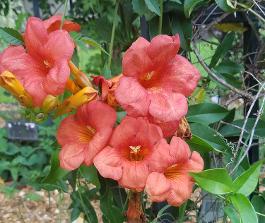
Trumpet Vine: A hardy vine capable of growing in almost every region, trumpet vine is characterized by colorful trumpet-shaped flowers that can attract swarms of hummingbirds to the garden in summer and early fall. Also known as trumpet creeper, hummingbird vine or campsis radicans, this deciduous climbing vine has dense, dark green leaves which are ideal for adding privacy along a fence or trellis. It can get out of hand so I prune mine every fall
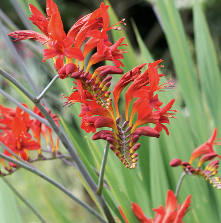
Crocosmia “Lucifer”: Gorgeous red flowers, with yellow to orange shaded accents bloom atop green, swordlike foliage. This hardy cultivar adds a tropical flair to my gardens. Tolerant of summer heat and humidity I usually over winter it inside. Recently told it can handle winter, I have left it planted outside Time will tell if it blooms and thrives. If it does, I will plant en masse next season
"Mosquito Geranium": I love this plant which is essentially prized for its citrusy scent. It is thought to hold mosquito-repelling properties. Found under a number of names, such as citronella plant, mosquito plant geranium, citrosa geranium and Pelargonium Citrosum, the plant is actually a variety of scented geranium that simply produces a citronella-like scent when the leaves are crushed. The mosquito plant geranium came about from taking specific genes of two other plants – Chinese citronella grass and African geranium.

Variegated Ribbongrass: is a perfect plant for adding a dose of color anywhere you don't want to maintain; it's a fast-spreading variety perfect for covering slopes and other areas. It earned its common name because the green leaves are beautifully striped in creamy white. It grows quite large, think tall. I use it as a focal point near my pond and in a whimsy garden.
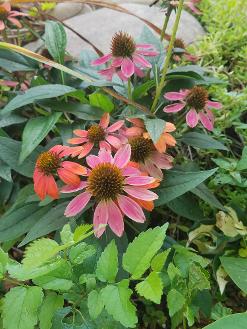
African daisy: Brilliantly colorful, this is not your typical white daisy, It produces a profusion of brightly colored flowers throughout the long summer blooming season. But this annual needs regular care, including an occasional trim. I like to bring the cuttings in for a colorful arrangement. Goes perfect alongside my DayLillys.

Yellow Day Lilly: These hardy flowers are loved by many. A perennial that performs year after year. I look for hybrids that re-bloom. You may also stagger planting them for more continuous blooming. There are different color varieties as well
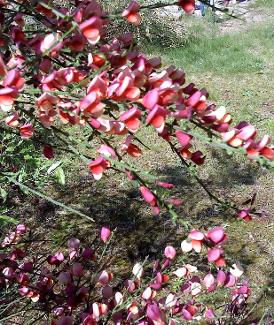
Broom: Where don’t they grow? The only space that is not pleasing to broom shrubs is a soggy, boggy and shady location. They establish quickly, and their adaptability and rapid growth can lead to an invasive tendency. I got some from a friend who was thinning out his plants.
I love the pea pod shaped blooms, but quickly found that my son had allergies to this plant. I now enjoy it in other people's gardens!

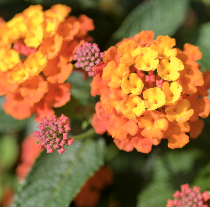
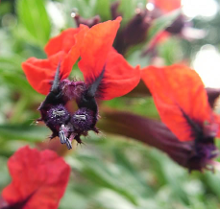
Hellebore: Love shade and bloom drooping, buttercup-like flowers of pink, mauve, white, green, burgundy, yellow, black-purple, bi-colored, speckled and more. These flowers last into the summer, becoming greener or darker with maturity.They make a spectacular cut flower and you can float the blooms in a shallow bow.
Butterfly Bush: This fragrant flowering shrub blooms throughout the summer and attracts butterflies, but it has proven invasive in the U.S. and detrimental to the life cycle of the pollinators it attracts. Birds carry off the seed to the point that it's popping up in fields and roadside areas. Replace butterfly bush with native plants that are as easy to care for but support a greater number and diversity of pollinating insects.
Lantana: These beautiful bloomers are drought resistant and heat loving. They are perfect for hanging containers, flower boxes or for making a stunning splash in your garden. Attractive to butterflies and other helpful pollinators,
Bat Face Flowers: Cuphea llavea, are low maintenance, shrubby perennials native to Mexico (but annual in colder climates). Bat Face Cupheas produce masses of 1" purple tubular flowers with two bright red, upward facing petals all along the stem. They are very drought-tolerant plants.
Copyright All for a Garden 2025